I love Spring, and when I was growing up, Easter was the big spring celebration in our house. Even when money was tight, I always had new shoes and a new dress (When we lived on Aunt Sadie’s chicken ranch, it was made from a flowered cotton feed sack, and my mother’s fine stitching produced what was referred to by our neighbors as “baby haute couture”). New clothes required somewhere to show them off, so once I had grown out of Beautiful Baby contests (honest!), and Easter Parades, we always went to church on Easter Sunday.
During the years that I was married to the husband of my youth, we didn’t attend religious services, so I substituted other traditions, some of which seem to have stuck with the two children we raised together. Hiking to the top of a hill to camp and awakening to the sunrise; setting out the first seedlings in our vegetable garden, dying and hunting for hidden eggs. And Easter Egg Bread. It was always called that, even though I suspect that at the time my children had no clue about Easter. And the name has stuck. (Another Springtime tradition emerged during those years, that of the Easter Egg Tree, but more about that in next week’s post.)
As the years went by, we adopted spring traditions from new friends and old. As she aged and talked about her childhood, my mother reminisced about eating Hot Cross Buns (spiced sweet buns made with currants or raisins and marked with a cross on the top), fresh from the baker’s oven on Good Friday. So we began to make those too, at least when Mom visited us during Easter week. Coloring and hiding eggs lost its appeal as the (now four) children entered their teens, and new clothes and fancy hairdos took their place. But Easter Egg Bread, it appeared, was a tradition that everyone enjoyed.
My first Easter Egg Bread recipe came from the Farm Journal Homemade Bread book, the 1969 edition which has somehow escaped the many cullings of my recipe collection and still sits on my kitchen shelf. It was made using all-purpose flour, the typical milk/sugar/salt/shortening base of the day, and the grated peel of 2 lemons. I eventually adapted the recipe to our whole-grainy lifestyle, and that is the way it stayed. For a while I colored the eggs with onion peel or blueberry juice, but my children preferred the vibrant colors produced by commercial food coloring, so I gave in to their wishes.
I took a break from baking Easter Egg Bread after my children grew up and moved away. But this year I realized I could make three or four loaves with all the colored eggs my granddaughter had stashed in my fridge, so I located my copy of Organic Cooking for (not-so-organic )Mothers and set to work.
BUMGARNER EASTER EGG BREAD*
12 colored hard-cooked eggs. Refrigerate eggs until last kneading
1/2 cup milk
1/2 cup honey
1 teaspoon salt
1/2 cup fresh butter
grated peel of two lemons
2 Tablespoons active dry yeast dissolved in 1/4 cup warm water
2 eggs, beaten
4 1/2 – 5 cups whole wheat flour
1 beaten egg
poppy seeds or other decoration
Combine milk, honey, salt, butter and lemon peel. Heat in medium saucepan just until butter begins to melt. Cool to lukewarm. Meanwhile dissolve yeast in warm water, preferably in the same container that was used to measure the honey (that gives the yeast some food and gets it growing faster). Add to milk mixture after about five minutes, along with the beaten eggs and half the flour. Beat until smooth. (I always use a wooden spoon for that part, but if you have a bread machine that will do that for you, go for it.)
Stir in enough remaining flour, a little at a time, to form a dough you can handle with floured hands. Continue to add flour, kneading thoroughly until smooth and elastic. Place into a slightly oiled bowl, cover with a cloth, and allow to rise until doubled in bulk; about an hour. Punch down and form into four long ropes. Twist the ropes together, two at a time, to form loose braids on a cookie sheet, bringing the ends together to form a ring, and nestle six colored eggs in the loops made. Alternatively, form twelve dough circles, with one egg in each circle.
Allow dough to rise again until doubled; covered with a cloth to keep out drafts and passing children. Brush dough with a beaten egg; sprinkle with poppy seeds or finely slivered almonds. Bake for 25 to 30 minutes at 375 degrees F; about 20 minutes for individual rings. Serve warm
This bread can be personalized by the addition of raisins, currants, nuts, etc., and can also be made the night before and heated before serving. Enjoy.
*from Organic Cooking for (not-so-organic) Mothers, by Marlene A. Bumgarner
Share this post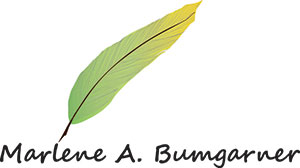
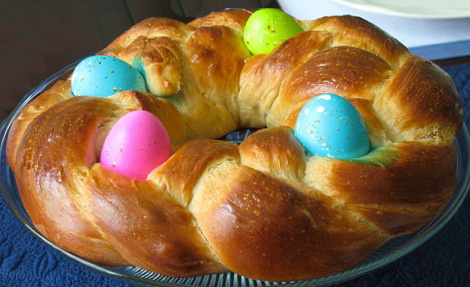
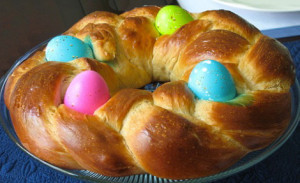
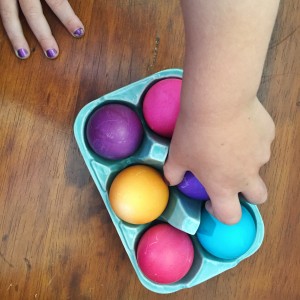
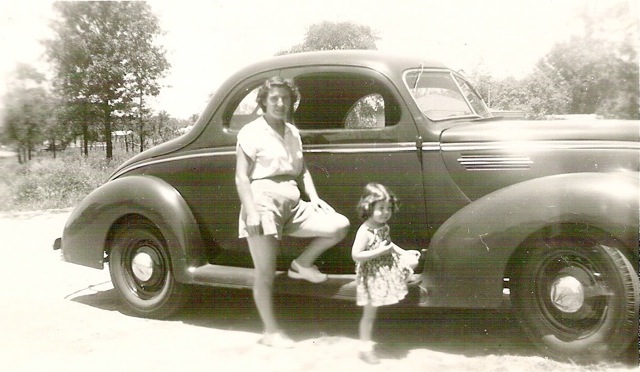

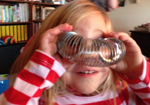

Easter egg bread a tradition. Farm Journal the best!
Martha,
I love your enthusiasm!
Marlene
What a lovely photo of you and your mother. Memories…
Thank you, Susan! It’s one of my favorites.